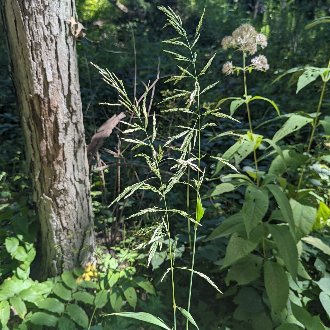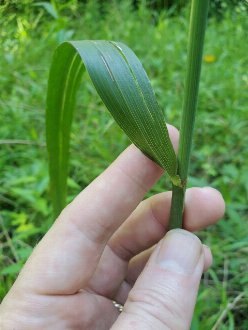Sweet Wood Reed (Cinna arundinacea L.)
Also known as sweet woodreed, sweet wood-reed, stout woodreed, wood reed grass.
↑Summary
A tall perennial grass native to Eastern North America, usually found in wet to moist wooded areas.
↑Range - Expand
| Legend | Color |
| Native | |
| Native or Not Present |
This tentative map is based on our own research. It may have limited data on Canada and/or Mexico, and there is some subjectivity in our assignment of plants as introduced vs. expanded. Read more in this blog post.
Although this plant occurs somewhere in each of these regions, it may only occur in a small part of some or all of them.
↑Habitat
Sweet wood reed occurs in a variety of moist, lightly shaded habitats. Common natural habitats include floodplain forests, swamps, openings or clearings in moist bottomland woods, and moist spots in savannas. Uncommonly, it can also occur on moist spots in sunny habitats, or in mesic woodlands. It can sometimes thrive in anthropogenic habitats such as small fragmented bottomland forests or thickets in urban, suburban, or industrial areas.
This species mostly inhabits a narrow range of moisture conditions during the growing season, described as moist to wet. Ideally, the soil stays consistently moist and does not dry out. It ranges into mesic conditions more in the north of its range, but is still uncommon there. Although it tolerates waterlogged soil, it tolerates only brief, temporary flooding, and cannot grow where there is standing water for long periods during the growing season.
It is usually limited to sites with well-developed soils rich in organic matter, often but not always alluvial soils. It tolerates a wide range of soil pH, between 4.0 and 8.5. It prefers loamy soils, although some sand content is tolerated on consistently-moist sites, and some clay content is tolerated on sufficiently well-drained sites.
It is resistant to deer browsing and tends to increase slightly in areas heavily browsed by deer, which may be a factor in its occurrence in fragmented urban and suburban woodlands.
↑Life Cycle
This species is a tall, clump-forming perennial grass. Different sources alternately classify it as a "warm-season" or "cool season" grass. Although it uses C3 metabolism (lumping it in with so-called "cool-season grasses"), not the water-conserving C4 metabolism that most grasses growing in the summer use, this species tends to mature later than the cool-season grasses, with most of its growth occurring in summer, which is why some sources classify it as a "warm-season" grass. It could be described as a C3 grass that grows during the warm season, and this combination of traits is reflected in its higher moisture demands and greater shade-tolerance relative to most C4 species.
The growth habit is upright; plants will remain upright even in the absence of supporting vegetation. However this upright habit also enables this species to compete favorably with ground-level vegetation, which tends to be significantly shorter than it in the habitats in which it occurs. Foliage emerges later in spring than most C3 grasses; height tends to increase throughout the growing season. Plants begin flowering in late summer, rarely earlier, and continue into early fall. Blooming is staggered and some plants may be still blooming when others have had their seed fully mature.
Plants can be slow to establish, do not usually reach their full height in their first year, and may not bloom. Plants often reach their maximum height in their second year but usually not their full extent. On favorable sites, clumps expand in size and grow multiple stems, but there is no long-distance vegetative reproduction.
Plants tend to be long-lived as long as favorable conditions persist. Mortality can occur from a variety of factors, including drought on sunnier or drier sites, prolonged flooding on lower, wetter sites, herbivory, or heavy shade from a closed canopy of trees or shrubs, especially on undisturbed, better-drained sites. Plants can also be outcompeted by taller herbaceous vegetation on sites able to support such vegetation.
↑Faunal Associations
Deer usually ignore this grass because its foliage emerges during a time when there is other more palatable vegetation widely available. Cattle and other livestock will browse this grass if given the opportunity, such as if a pasture includes a wooded bottomland area. Birds eat the seeds, and also use the plant for nesting material. This species is important as cover for small mammals and birds, as it is among the tallest herbaceous plants in its habitat.
Relatively little is known about insects eating this grass. It is eaten by the larvae of at least four skippers of the Amblyscirtes genus: Bell's Roadside Skipper (Amblyscirtes belli) and the Pepper-and-Salt Skipper (Amblyscirtes hegon), both of which eat a variety of grasses, Linda's Roadside Skipper (Amblyscirtes linda), and the generalist common roadside skipper (Amblyscirtes vialis). The fall armyworm (Spodoptera frugiperda), which eats a variety of grasses, has been recorded eating this species; this insect (and likely others) is slowed down by symbiotic fungal endophytes which sometimes colonize this plant.
Damage from leaf miners has been observed on the leaf blades, and parasitic wasps that eat leaf miners have also been observed on this plant, but we have not yet found any description or identification of leaf-mining species recorded consuming this species.
↑Uses
This species is uncommonly used as a landscaping plant, where it is valued for its ability to be grown in with other perennials, and its ability to remain upright even without being supported by other vegetation. It is more demanding of consistent moisture than most grasses, even relative to other grasses that occur in wetlands.
This grass can also be used in ecological restoration of riparian and other bottomland areas, where it is effective for erosion control and often competes favorably against invasive forbs. It can establish even in areas with heavy deer browsing, although it often establishes slowly. It is one of many species recommended as a replacement for reed canary grass (Phalaris arundinacea), which can become invasive, as well as for Japanese stiltgrass (Microstegium vimineum).
It can also be used in partly-shaded stormwater retention ponds.
↑Related Plants
There are two other Cinna species native to North America; the rare and endangered Bolander's woodreed (Cinna bolanderi) does not overlap with this species in range, but the drooping woodreed (Cinna latifolia) overlaps in the north of this species' range, with a larger area of overlap in the northeast than in the upper Midwest.
Although there are at least four other genera in the Cinninae tribe globally, none of these other genera occur anywhere in North America. The broader Supersubtribe Poodinae contains numerous other grasses including both ones native and introduced in North America.
↑Notes
We recommend avoiding the common name "stout wood reed" because this plant is not particularly stout; it has a slender, upright growth habit and has among the more slender stems and horizontally-contained growth habits of other vegetation as tall as it. The term "sweet wood reed" is not particularly descriptive but we have chosen it as the less-misleading of the two terms that are widely used.
↑Links & External Resources
• Cinna arundinacea (Stout Wood Reed) | Illinois Wildflowers (About This Site)
• Cinna arundinacea (sweet woodreed) | USDA PLANTS Database (About This Site)
• Cinna arundinacea | Go Botany (About This Site)
• Cinna arundinacea (Wood Reed Grass) | Missouri Botanical Garden Plant Finder (About This Site)
• Cinna arundinacea | Biota of North America Project (BONAP) (About This Site)
• Cinna arundinacea | NatureServe Explorer (About This Site)
• Cinna arundinacea | Flora of North America (About This Site)
• Sweet Woodreed | Maryland Biodiversity Project (About This Site)
• Cinna arundinacea L. (Common Wood Reedgrass, Sweet Wood Reed-grass) | Digital Atlas of the Virginia Flora (About This Site)







